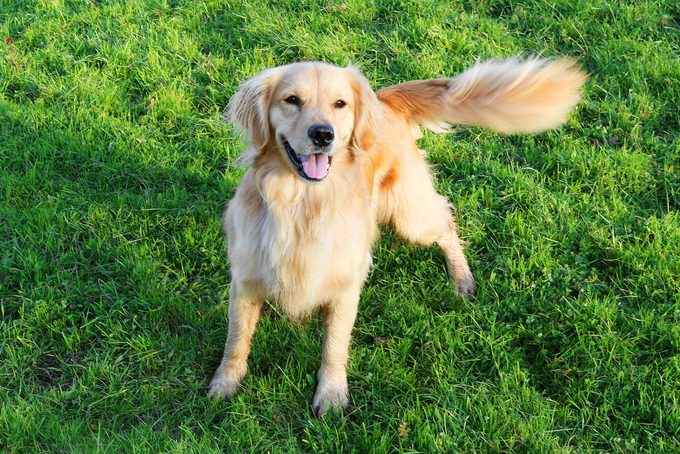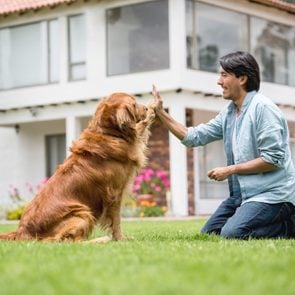Why Do Dogs Have Tails? A Vet Explains
Updated: May 06, 2024

Fluffy, curly, short or stumpy, tails are an adorable feature of our furry friends. But if not for human amusement, why do dogs have tails? A vet explains.
Nothing makes me feel quite as happy and welcomed as being greeted at the door by my tail-wagging German shepherds and English cocker spaniel. The rhythmic moving of their tails from side to side is soothing to my soul. But beyond showing displays of utter excitement, have you ever wondered what purpose a dog’s tail serves? Why do dogs have tails? You’re right in thinking that the entire existence of a tail isn’t simply to show off happiness—although that’s a great benefit.
As a board-certified veterinary behaviorist, I know just how much a dog’s tail is used in communication, but that’s not its only function. Ahead, I’m taking you on a deeper dive into some tail-related dog facts so you can learn once and for all why dogs have tails.
Get Reader’s Digest’s Read Up newsletter for more pet insights, cleaning, humor, travel, tech and fun facts all week long.
What are dogs’ tails made of?
A dog’s tail is an extension of its spine. It is made of interlocking bones called vertebrae along with a network of nerves and sensory receptors, covered by a layer of muscles. The muscles are then covered by skin and fur.
Why do dogs have tails?

A tail is a common feature found in vertebrates, and experts believe it most likely evolved to aid in locomotion. In some species, tails are used for balance and for swatting away insects. But in canids (dogs, wolves, coyotes, foxes), most of whom have tails, they are primarily used in communication. For dogs, the tail plays a big role in signaling to other dogs and people how it is feeling.
According to an article published in the journal Biology Letters, scientists believe that tail wagging may have either been a by-product of selection for other behavioral traits in dogs, such as docility and tameness, or purposely selected by humans “due to our proclivity for rhythmic stimuli.” So why do dogs need tails? Here’s what we know.
Tails help with communication
Decoding dog tail wags can be complex, as there are a variety of meanings behind the movement. But one thing is certain: Dog tails are used as a form of communication. Many people associate tail wagging as a positive sign. And while that can be true, this is not always the case. Tail wagging can be a sign of willingness to interact, in a negative or positive manner. A dog can wag its tail enthusiastically while jumping up and licking your face. However, a dog can also wag its tail while barking ferociously at another person or dog to tell them to keep their distance.
A dog with a tail that is raised high is considered a more confident or potentially aggressive dog. But some dogs that become excitable may also raise their tails to an elevated position, such as in greeting or play solicitation. Dogs that are exhibiting fearful or appeasing behavior would carry their tail lower or their tail may hang down. In dogs that are extremely anxious or fearful, the tail can be tucked between their legs and alongside their abdomen. Dogs with curly tails have the motor control to uncurl their tails and tuck the tail between their legs when they are physically or socially uncomfortable.
Tails signal emotions
The side on which a dog wags its tail—called wag bias—can actually signal its underlying emotional valence. A study published in iScience analyzed the movement trajectory of a beagle’s tail tip during dog-human interactions. The more familiar the person was through repeated interactions with the dog, the more likely the beagle’s tail wagged to the right side.
Wagging the tail more often to the left side indicated that the beagle was in a more negative emotional state, such as when they were shown pictures of unfamiliar people or aggressive dogs. Dogs can also read the tail asymmetry in other dogs. When one dog noted the left-side tail wagging of another dog, there was an increase in cardiac activity and the dog scored higher in anxious behavior. This indicated that dogs do rely on the direction of the tail wag to provide them with more social information regarding another person or dog.
Tails aid in balance
Many people have speculated that dogs use their tails to aid in balance while running and jumping. However, some dispute that theory. Recently, researchers who study animal locomotion at the Max Planck Institute for Intelligent Systems in Stuttgart looked at jumping border collies in a decade-long study. They found that the tail was not utilized when dogs were jumping. This biomechanical model was also applied to 25 canidae species, and scientists reached the conclusion that the tail currently plays a more important role in canidae communication rather than in locomotion.
Tails provide in warmth and comfort
Dogs bred in colder climates, such as Siberian huskies, tend to have long fluffy tails. In colder weather, dogs tend to curl up in a ball and wrap their tails around themselves, often tucking their nose into their tail. This is most likely a behavior they have learned to keep their nose and paws warm in cooler weather.
Do all dogs have tails?

Not all dogs have tails. There are certain breeds of dogs that are born without a tail due to a genetic mutation. The following dog breeds do not have tails:
- Pembroke Welsh corgi
- Australian shepherd
- Boston terrier
- English and French bulldogs
- Australian stumpy tail cattle dog
There are other breeds in which the tail is commonly amputated within a few days after birth, such as the cocker spaniel. In the United States, breeders frequently dock the tails of certain breeds to maintain the American breed standard. This practice started years ago with working breeds, which owners believed had a higher risk of injuring their tails. (They also did this to prevent sanitary issues or burrs and other items from getting stuck to the long fur on the tail.)
However, a study in Great Britain indicated that the risk of dogs injuring their tails is incredibly low. Approximately 0.23% of dogs in the country were found to be at risk of injuring their tails, but researchers concluded that 500 dogs would need to have their tails docked in order to prevent just one tail injury.
Tail docking has been banned in several European countries, where it is far more common to see certain breeds like the English cocker spaniel, Doberman and Rottweiler with their natural tails. Even after the surgery site has healed, some dogs may experience chronic pain or hyperalgesia, an increased sensitivity to pain, according to a study in Animals. In my opinion, it is an unnecessary cosmetic procedure. With the low risk of tail injury, there really is no longer a need to dock a dog’s tail.
How does the lack of a tail affect a dog?
Dogs with a docked tail or no tail may need to be more expressive in their overall body language to avoid ambiguity in signaling. The tail position and movement, along with the dog’s body language and facial expressions, send a message to other dogs and people regarding their emotional state.
For dogs without tails, people and dogs must pay closer attention to other aspects of the dog’s body language to determine if they should approach and interact or keep their distance from the dog. The dog with no tail may be at a higher risk of not clearly communicating its moods or intentions toward other dogs and people, which may lead to encounters they’d like to avoid. Dogs with tails may have a clearer line of communication within their species and toward humans.
Do some breeds use their tails more than others?
Yes—or at least that seems to be the case based on limited information. In Scott and Fuller’s classic study of dog breeds, they looked at four breeds of dogs. They noted a breed difference between cocker spaniels, which were more likely to wag their tails at the slightest stimulant, versus basenjis, which needed more stimulation to elicit a tail wag. Therefore, genetic factors may play a role in how dogs use their tails. Anecdotally, hunting-type dogs have been reported to wag their tails more frequently compared to shepherd-type dogs, but there are no specific studies to support that statement.
It is also interesting to note distinct differences in tail-wagging behavior between dogs and other canids, like wolves. A study published in Developmental Psychobiology looked at dog and wolf pups of the same age that were exposed to the same environment and caregivers. They found that the dog pups started to wag their tails at 4 to 5 weeks of age in the presence of the caregivers. The wolf pups were less likely to wag their tails in similar circumstances.
Do dogs have full control of their tails?
Dogs do have full control of their tails. The tail can be raised over the dog’s back and can either slow wag back and forth or move in a rapid motion side to side when they encounter other people or dogs. Dogs can control how high they raise their tail or how low they can tuck their tail. Dogs also can control the side-to-side wag. They tend to wag their tail to the left or right side in response to a person or situation.
Why trust us
At Reader’s Digest, we’re committed to producing high-quality content by writers with expertise and experience in their field in consultation with relevant, qualified experts. For this piece on why dogs wag their tails, Wailani Sung, DVM, DACVB, PhD, tapped her experience as a veterinarian and dog-behavior expert. Then veterinarian Amy Attas, VMD, gave it a rigorous review to ensure that all information is accurate and offers the best possible advice to readers. We verify all facts and data, back them with credible sourcing and revisit them over time to ensure they remain accurate and up to date. Read more about our team, our contributors and our editorial policies.
Sources:
- Biological Letters: “Why do dogs wag their tails?”
- iScience: “Left-right asymmetry and attractor-like dynamics of a dog’s tail-wagging during dog-human interactions”
- bioRxiv: “Tail wags the dog is unsupported by biomechanical modeling of canidae tails use during terrestrial motion”
- VetRecord: “Risk factors for tail injuries in dogs in Great Britain”
- Animals: “Tail docking of Canine Puppies: Reassessment of the Tail’s Role in Communication, the Acute Pain Caused by Docking and Interpretation of Behavioural Responses”
- Genetics and the Social Behaviour of the Dog




